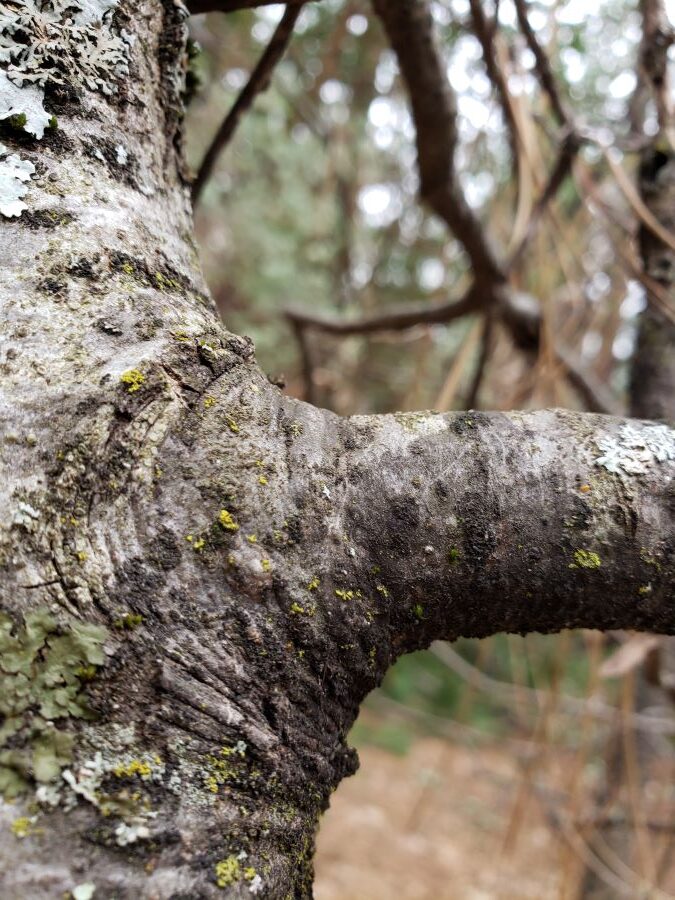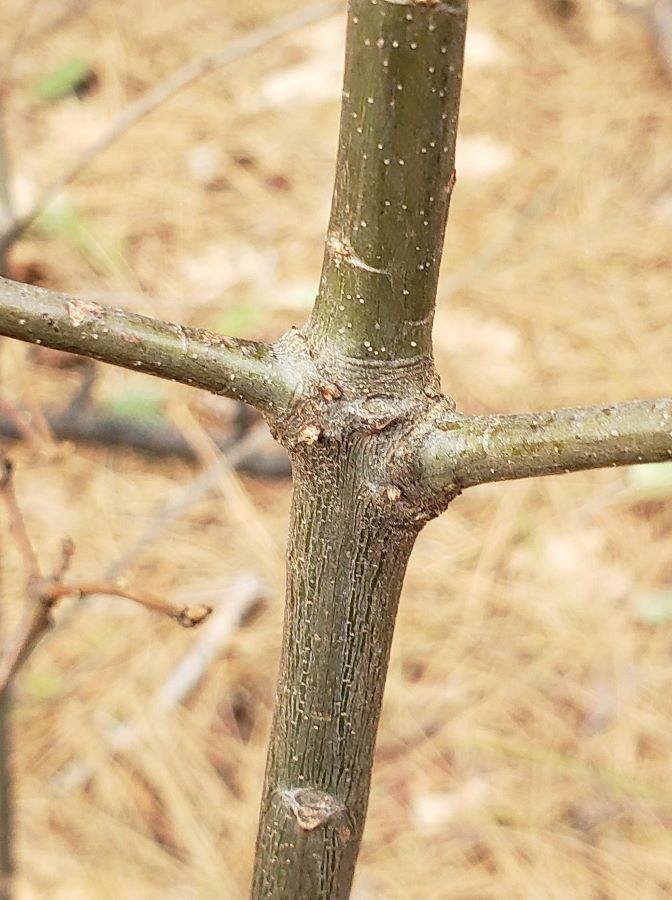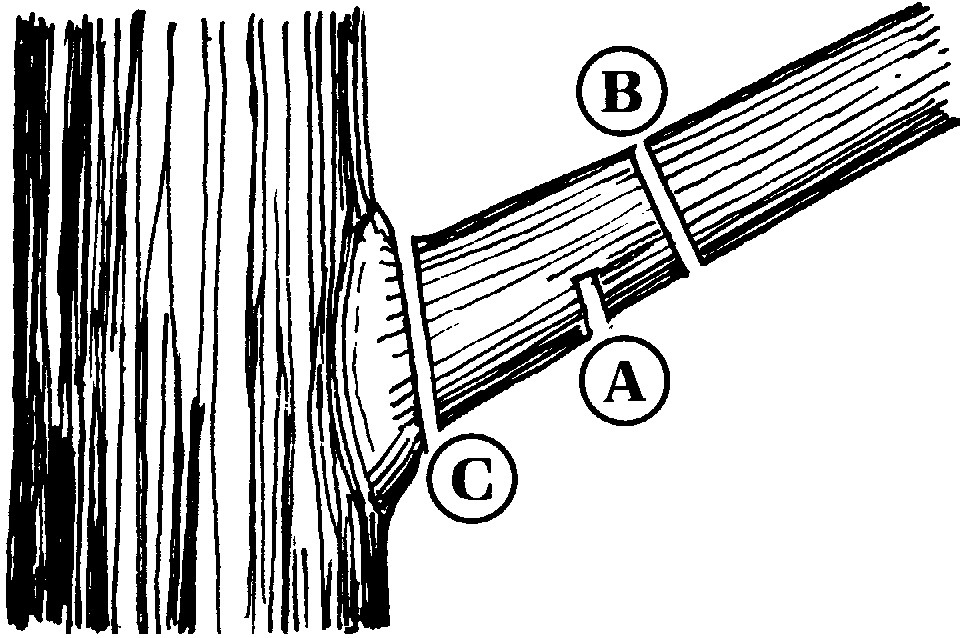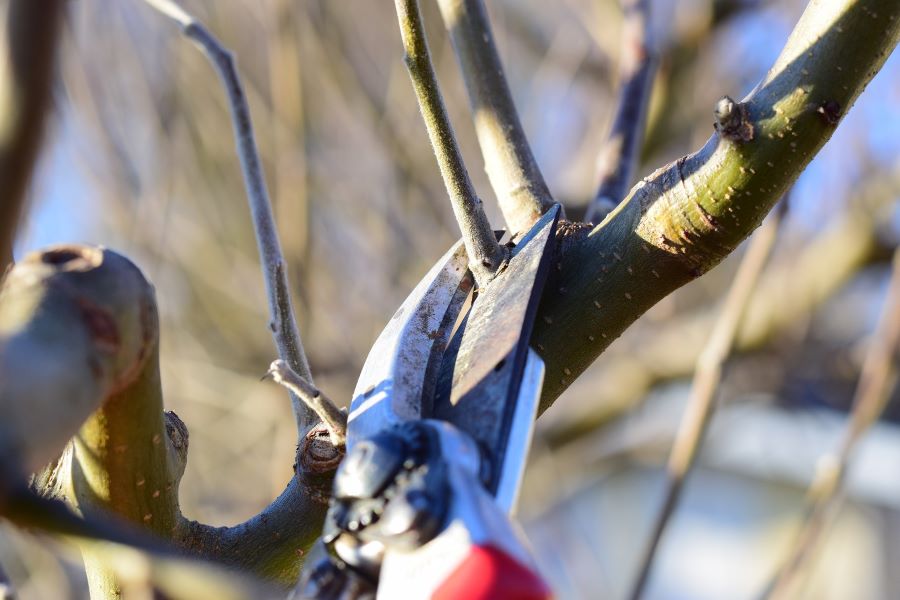This page contains an affiliate link where I earn a small commission if you purchase through the link, at no extra cost to you.
There are several pruning practices you should know and use to get the best results for your trees or shrubs—whether you’re pruning fruit trees or removing storm damaged branches.
How to make a good pruning cut
Use sharp, clean tools that are the right size for the job. Clippers, loppers, and a pruning saw to start. A chain saw if you need and can use one.
For clippers I highly recommend Felco #2. They are highly recommended by all professionals. I’ve had mine for over 30 years and simply can’t use another clipper. They are comfortable in your hand, stay sharp, and simply last. Get the #2, not another number (or brand). Trust me on this.


Be sure to cut right outside the branch collar. Or in the branch collar if you goof, it’s ok. The branch collar is a raised area surrounding the spot where the branch comes out of the trunk or larger limb. The branch collar holds the reserves necessary to grow protective tissue to start to cover the wound. Make sure you never cut flush with the trunk or limb. It has been shown that cutting into the branch collar doesn’t affect the collar’s performance, but it’s best to stay on the safe side and cut just outside it (on the branch side).
If you cut right into the trunk wood or limb, there is much less defense mechanism ready to kick in. It’s vulnerable to infection and insect pest infection. So avoid this at all costs. (See the article on using pruning seal or not for details on a tree’s defense mechanism.)
Trim any loose bark off the edges, if this is accessible.
Do not leave a branch stub!
This becomes a good entry point for decay diseases or an entry point for damaging insects. A stub of several inches is not good. Keep the cut as close to the outside edge of the branch collar as possible.
On smaller branches, when you make a heading cut—the ones that reduce the length of a branch—cut it on an angle so that it will shed rain water. This allows it to dry faster.
And cut it about a quarter of an inch above a bud on the branch.
For large branches
To safely cut a larger branch use the three-cut method. This method will avoid having the branch fall while still attached, tearing the trunk bark…worsening the damage.

- First Cut: A: Out several inches from where the final cut will be, make an undercut. This will prevent tearing trunk or limb bark when the branch falls.
- Second Cut: B: Further out from the undercut cut the whole branch. This takes the weight off so you can do the precision work on the third and final cut.
- Third Cut: C: In from the undercut, make the final cut right at the branch collar. Remember that it’s ok to cut into the branch collar a bit…but not into the trunk. If anything, angle the saw slightly away from the trunk when you cut.
Best time of the year to prune
The best times to prune are when the leaves are not forming or not falling. Winter or mid-summer is good, winter being preferable.
For conifers, late winter to early spring is the best time. But be careful, conifers do not grow back to fill empty spaces. Most don’t need any pruning, except to repair storm damage or for safety reasons.
With storm damage, prune right after it happens, which is usually winter, anyway.
How to deal with storm damage breaks
Prune the damaged branch off at the next limb or trunk. If the breaks are large or high, let a professional tree care person handle it. It should be cut as soon as possible.
Cleanliness during pruning matters
Do not sterilize a wound. Everywhere, there are good “bugs” and bad “bugs” present, and usually in balance. If you kill everything, you kill the good bugs, and that can allow even a tiny population of a fungus to take hold because there are no competitors or predators.
Sanitizing your tools is important. Soak the tools in a 70% solution of isopropyl alcohol for 2 minutes to keep pathogens from spreading. In infected wood, treat between each cut—it’s a lot, I know. Try keeping a small spray bottle on your belt as you work. It won’t be 2 minutes but it can help a lot.
Never Top a Tree
Cutting large branches to reduce the size of a tree makes a very unsafe tree. When a cut like that is made, watersprouts grow on many species of tree. Watersprouts grow fast, because there’s a lot of stored energy in the tree and many are produced close together. This is a natural response to keep the tree feeding itself.
BUT, the point of attachment of those branches to the tree is very weak. They can get broken off easily. When the tree branches are larger, this can cause damage to anything below.
The only time this type of pruning works is when it is managed as in coppicing or pollarding. You may have seen sycamores (as in Golden Gate Park) that have big knobs at the end of their fairly short branches. These knobs are highly maintained. The new branches are cut back to the knob every winter. The branches in leaf provide shade below in the summer. This is pollarding.
Pollarding is an ancient practice to provide wood for various needs: cooking fuel, basketry, and fencing, for example. The process starts early in the tree’s life, and is maintained yearly.
But topping creates dangerous situations for the tree and under the tree.
Always use good pruning practices when taking care of your landscape trees and shrubs. Know them when you need to remove damaged branches when storms hit them. A healthy landscape is an attractive one and a safe one—whether there is danger is from fire, to structures, or to people.

